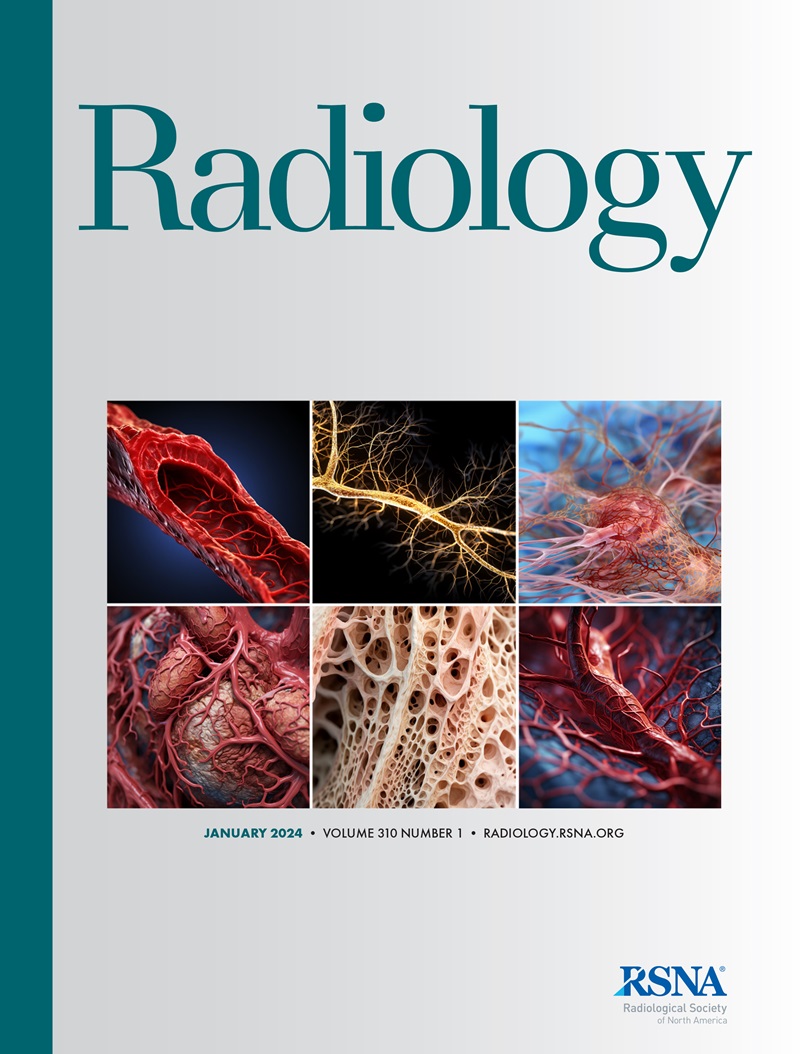Comparing Diagnostic Accuracy of Radiologists versus GPT-4V and Gemini Pro Vision Using Image Inputs from Diagnosis Please Cases.
Pae Sun Suh, Woo Hyun Shim, Chong Hyun Suh, Hwon Heo, Chae Ri Park, Hye Joung Eom, Kye Jin Park, Jooae Choe, Pyeong Hwa Kim, Hyo Jung Park, Yura Ahn, Ho Young Park, Yoonseok Choi, Chang-Yun Woo, Hyungjun Park
求助PDF
{"title":"Comparing Diagnostic Accuracy of Radiologists versus GPT-4V and Gemini Pro Vision Using Image Inputs from Diagnosis Please Cases.","authors":"Pae Sun Suh, Woo Hyun Shim, Chong Hyun Suh, Hwon Heo, Chae Ri Park, Hye Joung Eom, Kye Jin Park, Jooae Choe, Pyeong Hwa Kim, Hyo Jung Park, Yura Ahn, Ho Young Park, Yoonseok Choi, Chang-Yun Woo, Hyungjun Park","doi":"10.1148/radiol.240273","DOIUrl":null,"url":null,"abstract":"<p><p>Background The diagnostic abilities of multimodal large language models (LLMs) using direct image inputs and the impact of the temperature parameter of LLMs remain unexplored. Purpose To investigate the ability of GPT-4V and Gemini Pro Vision in generating differential diagnoses at different temperatures compared with radiologists using <i>Radiology</i> Diagnosis Please cases. Materials and Methods This retrospective study included Diagnosis Please cases published from January 2008 to October 2023. Input images included original images and captures of the textual patient history and figure legends (without imaging findings) from PDF files of each case. The LLMs were tasked with providing three differential diagnoses, repeated five times at temperatures 0, 0.5, and 1. Eight subspecialty-trained radiologists solved cases. An experienced radiologist compared generated and final diagnoses, considering the result correct if the generated diagnoses included the final diagnosis after five repetitions. Accuracy was assessed across models, temperatures, and radiology subspecialties, with statistical significance set at <i>P</i> < .007 after Bonferroni correction for multiple comparisons across the LLMs at the three temperatures and with radiologists. Results A total of 190 cases were included in neuroradiology (<i>n</i> = 53), multisystem (<i>n</i> = 27), gastrointestinal (<i>n</i> = 25), genitourinary (<i>n</i> = 23), musculoskeletal (<i>n</i> = 17), chest (<i>n</i> = 16), cardiovascular (<i>n</i> = 12), pediatric (<i>n</i> = 12), and breast (<i>n</i> = 5) subspecialties. Overall accuracy improved with increasing temperature settings (0, 0.5, 1) for both GPT-4V (41% [78 of 190 cases], 45% [86 of 190 cases], 49% [93 of 190 cases], respectively) and Gemini Pro Vision (29% [55 of 190 cases], 36% [69 of 190 cases], 39% [74 of 190 cases], respectively), although there was no evidence of a statistically significant difference after Bonferroni adjustment (GPT-4V, <i>P</i> = .12; Gemini Pro Vision, <i>P</i> = .04). The overall accuracy of radiologists (61% [115 of 190 cases]) was higher than that of Gemini Pro Vision at temperature 1 (T1) (<i>P</i> < .001), while no statistically significant difference was observed between radiologists and GPT-4V at T1 after Bonferroni adjustment (<i>P</i> = .02). Radiologists (range, 45%-88%) outperformed the LLMs at T1 (range, 24%-75%) in most subspecialties. Conclusion Using direct radiologic image inputs, GPT-4V and Gemini Pro Vision showed improved diagnostic accuracy with increasing temperature settings. Although GPT-4V slightly underperformed compared with radiologists, it nonetheless demonstrated promising potential as a supportive tool in diagnostic decision-making. © RSNA, 2024 See also the editorial by Nishino and Ballard in this issue.</p>","PeriodicalId":20896,"journal":{"name":"Radiology","volume":"312 1","pages":"e240273"},"PeriodicalIF":15.2000,"publicationDate":"2024-07-01","publicationTypes":"Journal Article","fieldsOfStudy":null,"isOpenAccess":false,"openAccessPdf":"","citationCount":"0","resultStr":null,"platform":"Semanticscholar","paperid":null,"PeriodicalName":"Radiology","FirstCategoryId":"3","ListUrlMain":"https://doi.org/10.1148/radiol.240273","RegionNum":1,"RegionCategory":"医学","ArticlePicture":[],"TitleCN":null,"AbstractTextCN":null,"PMCID":null,"EPubDate":"","PubModel":"","JCR":"Q1","JCRName":"RADIOLOGY, NUCLEAR MEDICINE & MEDICAL IMAGING","Score":null,"Total":0}
引用次数: 0
引用
批量引用
Abstract
Background The diagnostic abilities of multimodal large language models (LLMs) using direct image inputs and the impact of the temperature parameter of LLMs remain unexplored. Purpose To investigate the ability of GPT-4V and Gemini Pro Vision in generating differential diagnoses at different temperatures compared with radiologists using Radiology Diagnosis Please cases. Materials and Methods This retrospective study included Diagnosis Please cases published from January 2008 to October 2023. Input images included original images and captures of the textual patient history and figure legends (without imaging findings) from PDF files of each case. The LLMs were tasked with providing three differential diagnoses, repeated five times at temperatures 0, 0.5, and 1. Eight subspecialty-trained radiologists solved cases. An experienced radiologist compared generated and final diagnoses, considering the result correct if the generated diagnoses included the final diagnosis after five repetitions. Accuracy was assessed across models, temperatures, and radiology subspecialties, with statistical significance set at P < .007 after Bonferroni correction for multiple comparisons across the LLMs at the three temperatures and with radiologists. Results A total of 190 cases were included in neuroradiology (n = 53), multisystem (n = 27), gastrointestinal (n = 25), genitourinary (n = 23), musculoskeletal (n = 17), chest (n = 16), cardiovascular (n = 12), pediatric (n = 12), and breast (n = 5) subspecialties. Overall accuracy improved with increasing temperature settings (0, 0.5, 1) for both GPT-4V (41% [78 of 190 cases], 45% [86 of 190 cases], 49% [93 of 190 cases], respectively) and Gemini Pro Vision (29% [55 of 190 cases], 36% [69 of 190 cases], 39% [74 of 190 cases], respectively), although there was no evidence of a statistically significant difference after Bonferroni adjustment (GPT-4V, P = .12; Gemini Pro Vision, P = .04). The overall accuracy of radiologists (61% [115 of 190 cases]) was higher than that of Gemini Pro Vision at temperature 1 (T1) (P < .001), while no statistically significant difference was observed between radiologists and GPT-4V at T1 after Bonferroni adjustment (P = .02). Radiologists (range, 45%-88%) outperformed the LLMs at T1 (range, 24%-75%) in most subspecialties. Conclusion Using direct radiologic image inputs, GPT-4V and Gemini Pro Vision showed improved diagnostic accuracy with increasing temperature settings. Although GPT-4V slightly underperformed compared with radiologists, it nonetheless demonstrated promising potential as a supportive tool in diagnostic decision-making. © RSNA, 2024 See also the editorial by Nishino and Ballard in this issue.


